‘Rowing In the Same Direction’
A conversation with College of Medicine – Tucson Dean Michael Abecassis
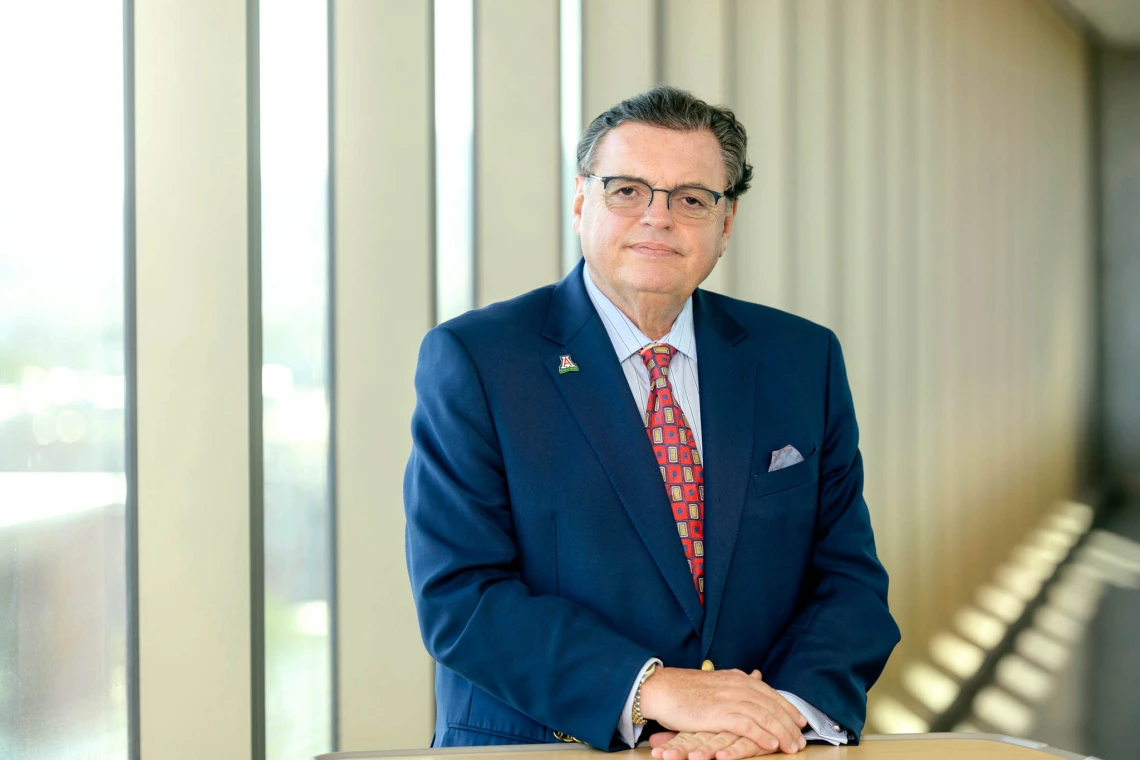
Michael Abecassis
Kris Hanning
Michael Abecassis recently finished his fifth year as dean of the College of Medicine – Tucson, a period that overlapped with both the COVID-19 pandemic and the aftershocks of the merger of Banner Health with the University of Arizona Medical Network. A challenging time in the school’s history, to say the least.
“I think the place had been neglected,” he says, reflecting on his start here. “There were seven interim chairs and three chairs waiting for a dean to show up to let them know they were retiring. That’s 10 departments with no vision, no plan. Other departments were just floundering. I saw it as a huge opportunity to make a difference.”
Born in Tangier, Morocco, Abecassis grew up in Toronto, where he trained as a transplant surgeon for the liver, pancreas and kidney. He went to the University of Iowa in 1991, then to Northwestern University’s Feinberg School of Medicine to direct what was then its new liver transplant program.
He was happy in Chicago. Raised children. Loved his house. Had community. Then came breakfast in Scottsdale with Larry Goldberg, then-president of Banner – University Medicine. Goldberg suggested that Abecassis interview for the dean here. “Why would I want to do that?” Abecassis said. Then a meeting with U of A’s then-president — and fellow transplant surgeon — Robert Robbins in the bar of the Drake Hotel in Chicago. “He says, ‘Larry Goldberg said that you might be interested in coming to Tucson as a dean.’ And I said, ‘Well, that’s not exactly how the conversation went.’”
That, of course, is what happened. (One important factor was Abecassis’ wife, who asked, among other questions, “How much longer are you going to keep getting up in the middle of the night to do transplants?”)
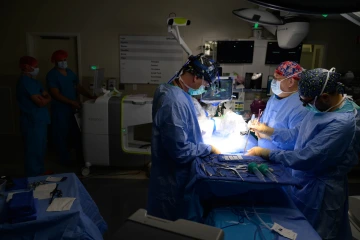
Kris Hanning
“My primary goal was to change the culture,” he says. “It was easy to do because I had to recruit all these new chairs and center directors” — one recent example being Hesham Sadek at the Sarver Heart Center. “If you select the right leaders, they bring in a culture that becomes a culture of the place.”
His pride in his work at COM – T is evident. “We went from a $200 million loss in this market to, last year, a million short of being profitable in a $1.9 billion budget,” he says, by way of example. He also knows there’s still plenty to accomplish. “The College of Medicine should be here,” he says, holding his hand flat in the air. He moves his hand down, “It’s here.” Then he moves his hand high up. “And it could be here. And I thought we can do it, so here I am.”
Q: Let’s start with something basic. Where’d you grow up? Where do you come from? How’d you end up a liver transplant surgeon?
A: I grew up in Toronto, in Canada. Went to school there. Undergraduate, medical school, residency training — all my training was there. So, I did my residency, and then I did a fellowship in hepato-pancreato-biliary surgery. That’s surgery of the liver and pancreas and biliary tree. And then I did a liver transplant fellowship, because liver transplants were just starting to take off. Toronto wanted to have a liver transplant program. When I was doing a postdoc in the lab, I would go down to Pittsburgh, because this was Pittsburgh’s heyday with Tom Starzl, who was the father of liver transplants. I would go down to Pittsburgh to learn the procedures.
And then — again, when I was still doing my postdoc — we started the liver transplant program [in Toronto], so I became involved with that. Eventually, the chairman at the University of Toronto, Dr. Bernard Langer, called me into his office and offered me a job to stay at the University of Toronto as part of the liver transplant team.
You may or may not know this, but insulin was discovered at the University of Toronto, at the Banting and Best Institute. And Dr. Langer felt really embarrassed that this is where insulin was developed for diabetic patients, but Canada did not have a pancreas transplant program for diabetes. So, [he] pulled me into his office at the Banting and Best Institute. Told me that he wanted me to become a faculty member there, which was a great honor — if you were at the University of Toronto, that was, like, the biggest honor. And then he said, “But I’m embarrassed, because we don’t have a pancreas transplant program, so why don’t you go learn how to do those things and come back and be the first Canadian surgeon to do one?”
Those were his words. And then he said, “And by the way, why don’t you learn how to do kidney transplants too?” Because in the British system, which was the Canadian system, kidney transplants were being done by urologists, not by the general surgeons. And he thought that I should do the first pancreas transplant in Canada and be the first abdominal transplant surgeon in Canada, which meant doing the liver, pancreas, kidney.
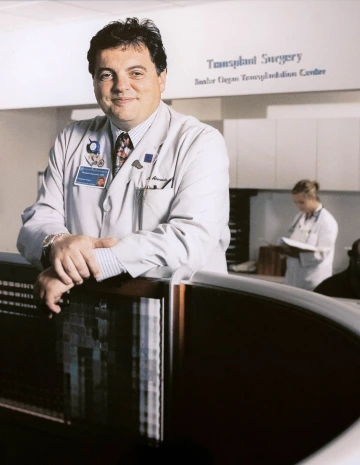
A young Dr. Abecassis
Provided by Abecassis
I ended up going to the University of Iowa to learn how to do pancreas and kidney transplants, but I had this grant to do research with a world-renowned transplant immunologist. So, you know, during the day, I operate on patients, and during the night I go to the lab and do research. And while I was there, there was a young college student that came in with acute liver failure. She was dying. At that time, I was sending all their livers to Omaha. There were very few liver transplant programs. So, I was going to do the pancreas and kidney transplant, and the liver was going to go to Omaha.
And this college student’s parents had showed up, and they’d been talking to the nurses. When I came back to check on her, her dad came up to me, and he said, you know, “Is she going to make it?” And I said, “No.” And he said, “Well, why not?” And I said, “Well, her pupils are already dilated, and people with acute liver failure die of brain swelling.” And I said, “I think by the time she gets to one of these programs and they find a liver for her… I mean, this develops in hours.”
So he said, “I hear you know how to do liver transplants.” And I said, “Yeah, I do. How do you know that?” He said, “Well, the nurses have been talking. And I heard you have a liver, and I heard it’s blood type O.” And I said, “How do you know that?” And he says, “Well, the nurses have been talking.” And I said, “OK.” And he goes, “Why can’t you do her liver transplant?” And I said, “Because we don’t have a liver transplant program, and I’m a fellow learning how to do pancreas and kidney transplants.” And so I went off to the operating room to do this kidney and pancreas transplant, and I get paged by [transplant surgeon] Dr. Corry, Robert Corry. He wanted me in his office. I figured, oh boy, I must have done something really bad.
My primary goal was to change the culture. It was easy to do because I had to recruit all these new chairs and center directors. Those people, if you select them right, bring in a culture that becomes a culture of the place.
So, I run down to his office. He had sent another surgeon to do the kidney and pancreas. I walked in, and there were some very high-level people from the University of Iowa there, and they said, “You’re going to do a liver transplant today.” And I said, “What are you talking about?” And they said, “Well, [the student’s] dad has gone to” — I think it was, at the time, the CEO and the dean; he’d gotten very high — “and said something to the effect of ‘My daughter’s dying, we have a liver, we have a guy that knows how to do it. So, I’ll make it very simple: If you don’t do it, I’m going to sue you, and if you do it, I’ll give you a lot of money.’”
So, I end up doing a liver transplant. The young woman did fine. Then Dr. Corry and the chair of medicine came to see me, and they said, “You’re not going back to Toronto.”
Q: You’re a professor at the BIO5 Institute here, which draws from 19 colleges and 84 departments across the university. You’ve given interviews to Tech Launch Arizona about the importance of educating medical students about things like intellectual property. Tell us about the relationships COM – T is cultivating with other departments in the university to facilitate interdisciplinarity.
A: I’ll cite, for example, that we are working on a new bachelor’s of science in medical device technology and development, which is one of a kind. Jameshia [Granberry, executive director of administrative operations and chief of staff at the college,] is spearheading that. It’ll be medicine, engineering, the business school, the law school and Tech Launch Arizona.
My goal is to have kids come out of high school that have an interest in subjects related to health and give them 12 to 15 months of a medical education so that they are fluent in the language of medicine: anatomy, physiology, the basics. Then they have to be fluent in the language of engineering as it relates to medical devices: what’s CAD, for example. Then they have to learn the language of business as it relates to devices and in general. You know, how do you create a pro forma, a business plan? Read a P and L statement? What are the four Ps? You know, some marketing. Then they go to law school and learn all the regulatory requirements; you know: What’s the FDA, what’s an IND, what’s an IDE? How do you mitigate against when a device goes bad and there’s a big lawsuit? And then finally, with Tech Launch Arizona, how do you monetize discovery? How do you go from discovery to commercialization? What’s a Series A, what’s a Series B, what’s a Series C?
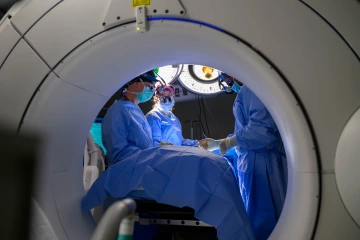
Kris Hanning
Then we’re going to send the students to the operating room see how medical devices are being implanted. Go to the large animal facility where they’re testing these things. Go do a six-week co-op with a local biomedical, biotechnical, pharma company, you know? See how the real world works. So that’s four years. We’re proposing it to ABOR this summer and it’ll go live fall of ’25.
You know, a lot of people talk about interdisciplinary or multidisciplinary. I talk about transdisciplinary: It’s got to cut across the disciplines. And the other part is that every discipline really needs the other, rather than one discipline trying to do it all. I have 29 academic units that report to me: 17 clinical departments, five basic science departments and seven centers. When I came in [to COM – T], there was immediate recognition that they’re not aligned. Everybody’s doing their own thing. It’s like Brownian motion. There’s no alignment. And so I thought, we need to align these units to be going in the same direction, be rowing in the same direction, have the same finish line in mind.
Q: Tucson has higher poverty rates than most Western cities its size. Overdose rates in Pima County were at an all-time high in 2023. How is COM – T preparing students to face these sorts of challenges, and what kind of outreach programs are you cultivating within the immediate local community?
A: A lot of this is based on fentanyl. It’s based on people being addicted. Addiction is a disease, so coming up with nonaddictive ways to treat pain is very important. So we’ve developed [the University of Arizona Health Sciences Comprehensive Center for Pain and Addiction] to try to find ways around having to use narcotics and addictive drugs. That’s a long-term approach.
And it’s not just that there’s a poor community [in Tucson]. I think, as important as that, there’s an underrepresented, underserved community. So the medical school has a program called the Pre-Medical Admissions Pathway [P-MAP], which makes an effort to admit 10 medical students into our medical school class that come from underserved, underrepresented communities. We pick them up as undergraduates, we help them get into medical school, we help them get through medical school.
Now, we also have a program that was started four years ago where we have state allocation for tuition, but for every year your tuition is paid by the scholarship, you have to go back and serve your community for a year in a primary care setting. And what we found is that in the first year we gave those scholarships, 30% of them went to P-MAP students, because [those students] wanted to go back and serve their communities. They’re going to become physicians familiar [with these issues] because they learn in an environment where those issues are present. I think that’s a big one, and we need to do more of that.
Now, when I got here, they told me, “We have this program. It’s great.” Then they said, “But the grant is ending, so we’re going to end the program.” I said, “Over my dead body. I’ll go rob banks if I have to, but we’re going to fund the program.” And we did it. We’re doing it.
A lot of people talk about interdisciplinary or multidisciplinary. I talk about transdisciplinary: It’s got to cut across the disciplines. And the other part is that every discipline really needs the other, rather than one discipline trying to do it all.
At the end of the day, it’s all about getting the necessary funds to be able to support those efforts. There’s no easy answer. There’s no one magic bullet that’s going to get it done. It’s persistence.
Q: Over the past couple of years, we’ve seen what are effectively total abortion bans in states like Idaho, Indiana and Kentucky. How do you think about administering medical education in the face of conflicts at the state legislative level?
A: Human beings are still here because we adapt. You have to react, and you have to adapt, and you have to do what’s right in terms of educating our students and residents without breaking any laws. You know, we all live with the limitations of our environment, and none of us want to end up in jail.
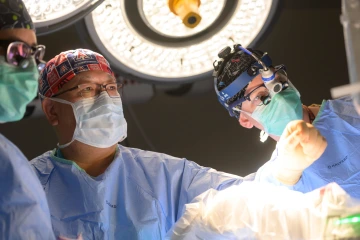
Kris Hanning
This applies to diversity, equity and inclusion, too. The first thing I did [when I arrived] was appoint a vice dean for DEI — [Celia Valenzuela, who is also an associate professor in obstetrics and gynecology]. We’re a Hispanic Serving Institution. We have the land grant. We have to be very active about looking at underserved and underrepresented communities, whether it’s gender or anything else. But if you have those three letters, you basically have a target on you. You’re at risk for having somebody say, “You cannot do those things. You get no funding to do that, and you can’t do that.” So we had a dean’s suite meeting where we tried to explore how we could continue to do the things that we believe are important and not be at risk. I said, “You know, DEI is a hot-button issue. Why don’t we think about what we want to do that doesn’t include those three letters?”
So, we just officially changed to — actually, I got outvoted. I wanted it to be ABC, and it’s now ACB, because the vice dean didn’t want to be a vice dean of ABCs. So, it’s access, community and belonging. “Access” implies equal access. Access to health, access to education, access to whatever is relevant to the faculty and student community. It’s, “We’re all one community.” And then “belonging”: Everybody needs to feel like they belong to that community.
It’s the same thing as the abortion issue: Let’s just do what we need to do without taking on fights. You know, I’m not a political person. If I see politics, I cross the street, because there’s no winning. I’m hoping that common sense prevails and that we just do what we all believe is right and that no one would argue is the right thing to do without raising flags.
Q: You have an interest in literature and classics, in particular Rimbaud.
A: My dad was a professor of Latin, Greek and French philosophy. He used to get all these journals on French philosophy, and I used to read them. So, when I went to college, I took a course in French philosophy. And the exam was basically a three-hour in-class essay, and you got a choice of a few topics and authors. And we knew there would be a potential to write the essay on Rimbaud and his works.
I happened to be going to a wedding that Sunday night with my parents, because it was a family friend. My exam was on Monday. So, I was sitting at the table with my dad, and I said, “You know, I’m taking this exam tomorrow, and I’m thinking of writing something on Rimbaud.” And he said, “OK, well, let me tell you what I think about him,” right? He starts literally giving me his impressions on Rimbaud. And it was at a wedding. So, I’m half listening, half not-listening.
And when the exam came, it turns out Rimbaud was one of [the topic choices], so I wrote this essay on Rimbaud. Part of it was mine, part of it was regurgitating what [my dad] had said. And I get this notice that I won the Squair French Prose Prize for the University of Toronto. A bunch of money. I got this prize literally from listening to my dad during a wedding. I thought that was cool, but I didn’t think I would make a living doing that, so I figured I better do something professional.
But I’ve always been a big [fan of] the existentialists. I loved reading Jean-Paul Sartre and Albert Camus. When COVID hit, I decided I need to write a personal something every week to the faculty to let them know what was going on. I did this for about a year. And I always started with a quote relevant to what I would write, whether it was Sartre, Camus or even Voltaire. And some of the faculty really got into it. In fact, [Joseph] Alpert — cardiologist, been here forever — was starting to text me, because his favorite book was [Albert Camus’] “La Peste” — you know, “The Plague.” He started, like, commenting on my comments. You know, COVID was like “La Peste.” It started this whole thing. I probably got a half a dozen people here that were really into this thing.
